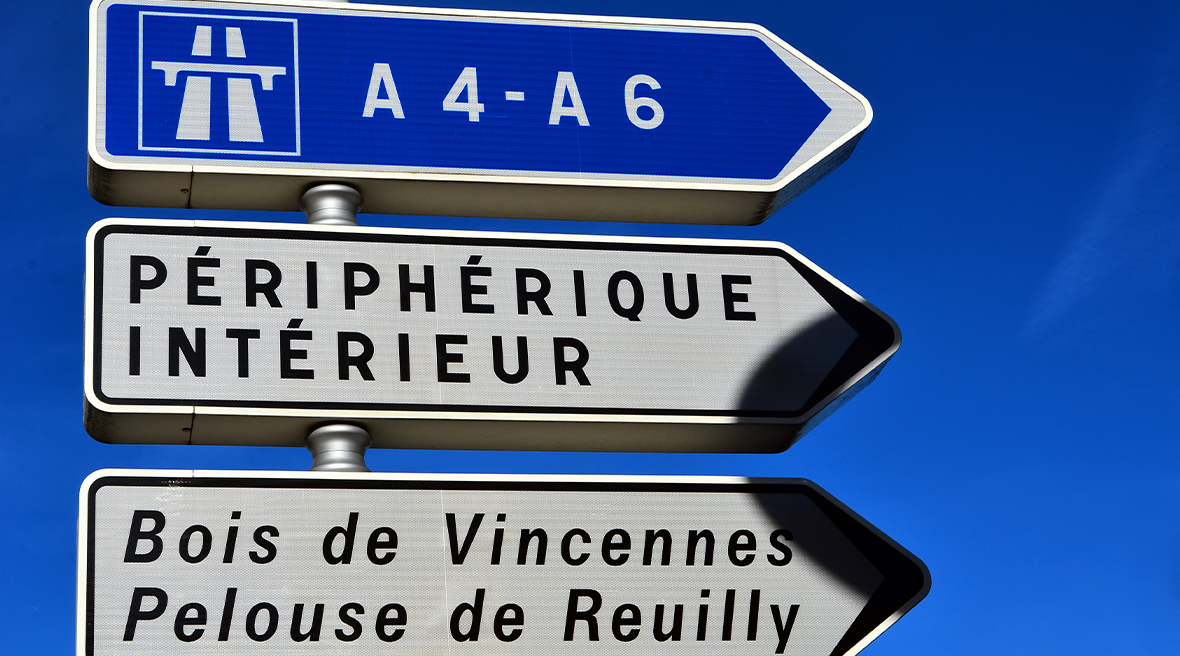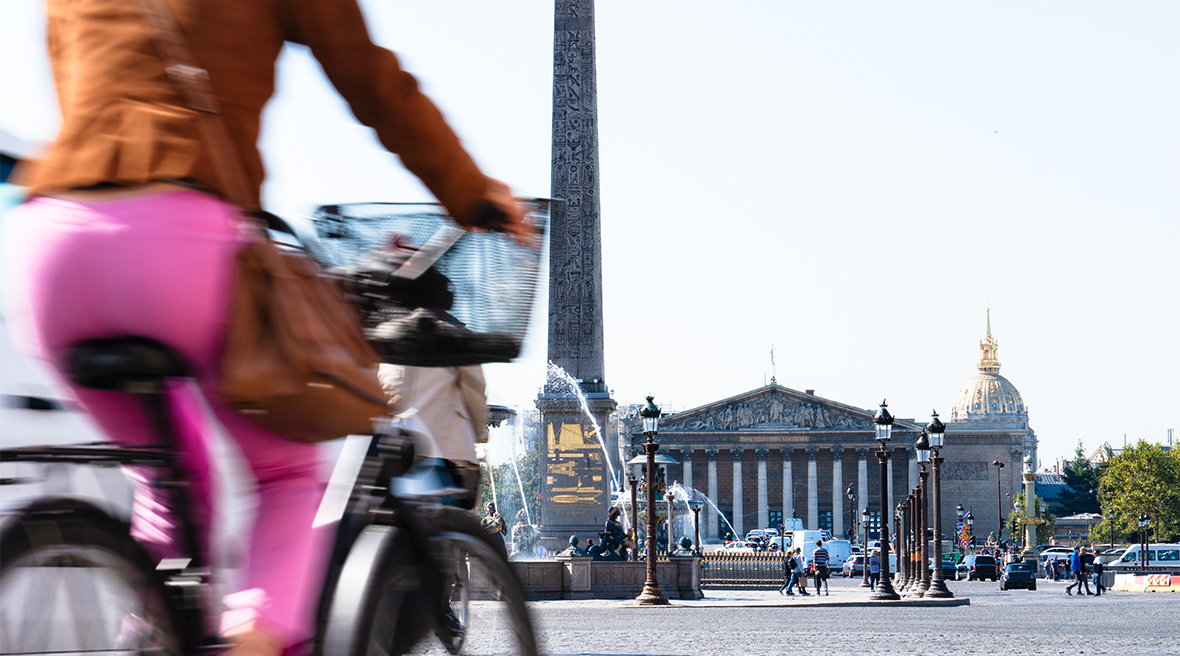Driving in the centre of Paris is possible – for now – but there are things you need to know before you go. This article explains how to get into the French capital by car, gives advice for driving around the centre, the latest on Crit'Air stickers and the low emission zone, as well as a few tips on parking.
Driving to Paris by car
There have been plenty of headlines over recent years about Paris ‘banning cars’. The city already has one of the most stringent low emission schemes of European capitals (more on that below), and Paris Mayor Anne Hidalgo, who’s been in office since 2014, has always been passionate about green issues.
Over 900 miles of cycle lanes have been created in Paris and there has been a 71% jump in bike usage since the pandemic. Huge squares like Place de la Madeleine, Place de la Nation and Place de la Bastille are now more pedestrian-friendly. Hidalgo has long had plans to ban all diesel cars from the city centre, and it had been thought that those plans would become law in 2024, in time for the Paris Summer Games. However, it now seems that a complete ban on diesel cars will not come into force quite yet.
People driving to Paris from the UK should still be aware of the new regulations affecting parking, and the driving restrictions already in place.
Paris’ ring road - La Périphérique
The first thing you have to navigate when you approach Paris in the car is the Périphérique ring road or La Périph (pronounced ‘pey-reef’) to locals. It’s like the M25 but a lot smaller (21 miles around, in comparison to 117) and much more central.

Don’t forget there’s an inner and an outer ring of the Périphérique
You’ll get on the Périph via one of the Portes (aka junctions) dotted around the city’s circumference; there are generally four lanes and all exits are on the right. So far, so simple? Well, think again.
The French have thrown in a curveball or two, the first of which is the direction of travel: the Périphérique is divided into an outer and an inner ring, one of which goes clockwise and the other anti-clockwise, so plan your route carefully. The second wrinkle is the lack of hard shoulder, which means that when accidents or breakdowns happen, the road gets snarled up quickly and lengthy tailbacks occur.
The speed limit on the Périph is 70kph but it’s anyone’s guess how many people follow it stringently despite the regular sprinkle of fixed and mobile speed cameras. Keep your eyes peeled for cameras, and for scooters and motorbikes weaving in and out of your peripheral vision at hairy speeds.
You’ll see plenty of petrol stations on the Périph so stock up on fuel before leaving the ring road and venturing into the belly of the beast. Final word of advice: French drivers love a horn so don’t let the stereo crescendo of hoots and toots distract you from your driving.
Driving in Paris as a tourist
Paris may have a backbone of boulevards and spacious squares, but it also has a million veins of tiny narrow cobblestone streets connecting everything. It can be a sensory overload to drive there with horns honking, cars shuddering, statues looming, motorbikes revving and policemen whistling all around you.
If it feels like Paris is becoming something of a no-go zone for drivers, don’t be fooled. Be prepared for roads to still be busy.
Here are a few key things to be aware of if you are making your way into the city.
The Crit'Air sticker

There are over 70% more cyclists on Parisian streets than in 2020
Crit’Air is France’s national system for controlling pollution levels in cities; you have to display a sticker in your car to show how polluting your vehicle is. You might not be permitted to drive into the city if your car’s emissions are too high. Central Paris is part of a permanent low-emissions zone (ZCR) that means all vehicles need to display a Crit’Air vignette or sticker to be allowed entry during certain times. The sticker is relatively cheap but you need to buy it in advance because you will be fined if you’re seen driving without one.
The boundary of the low emissions zone is the A86, the intermediate ring road in Paris, outside the Périphérique ring. In 2024, if your car is in the Crit’Air 4 or 5 category, you will not be allowed to drive within the ZCR. It is expected that the ban will be extended to Crit’Air 3 vehicles (cars with diesel engines manufactured before 2011, and pre-2006 registered petrol cars) by 2025.
Right of way
Always yield to vehicles on your right; you’ll see ‘priorité à droite’ signs reminding you to do so.
Speed limits in Paris
The speed limit on the bigger roads is 50km per hour (around 30mph) but this reduces to 30km per hour in small streets, busy pedestrian areas and school zones. The speed limit is painted on the ground or on road signs.
French traffic lights
You have to stop at every red light. Traffic lights are usually mounted on a pole on the side of the road and can sometimes be hard to spot.
French fuel prices
You may find that prices at the pumps are higher in France than the UK. Drivers will see petrol being quite a bit more expensive than the equivalent price at home. This is due to a higher level of fuel tax in France and VAT than in the UK, and a less competitive pricing culture amongst the major retailers.
Pedestrian areas or zones piétonnes
 The Champs-Elysées is closed to traffic on the first Sunday of every month
The Champs-Elysées is closed to traffic on the first Sunday of every month
Some areas of Paris are permanently pedestrian-only. These include the Les Halles district and various streets around Notre-Dame. In recent years the city has introduced a ban on driving in certain arrondissements on Sundays and public holidays. These are called the ‘Paris Respire’ areas, and currently include Montmartre, Canal Saint-Martin and the Marais district. The central 1st, 2nd, 3rd and 4th arrondissements are closed to traffic on the first Sunday of every month, encompassing the entire Champs-Elysées and the most popular tourist attractions.
Car parking in Paris
As you may expect in a big city, parking in Paris isn’t easy. If your hotel or holiday accommodation has a parking option, snap it up. Otherwise, it’s a choice between on-street payable parking or underground car parks.
Parking costs between €4 and €6 per hour but is usually free after 8pm and on Sundays and public holidays. Don’t park in areas meant for deliveries (livraisons) and taxis – if you park illegally in Paris, you might get clamped or towed.
If you can’t find a parking space, another option is to use one of the park and ride spots in the suburbs, and travel in on the Metro or RER train service.
Parking SUVs in Paris
The cost of parking an SUV, 4x4 or any vehicle weighing over 1.6 tonnes in Paris has recently gone up significantly. Parisians voted in favour of increasing the parking charges for these kind of vehicles to €18 an hour in the centre of the city.
Tips for driving in Paris
Once you have got your Crit’Air sticker, and made sure that you can legally enter central Paris in your car on the day you are travelling, here are some of the key things to remember about driving in France.
Alcohol limit
The limit is 50mg of alcohol in 100ml of blood. It is advisable not to drink and drive at all because if you are caught over the limit, the penalties are severe.
Low beam and headlights
Dipped headlights must be used in poor daytime visibility. You will also need to attach headlight converters on your UK car, so that the main beam does not dazzle drivers on the other side of the road.
Speed limits
The speed limit within central Paris will normally be 50 km/h. On the Périphérique the limit is 70 km/h, even though it is a dual carriageway where the standard speed limit is 110 km/h.
Roundabouts
 The Arc de Triomphe is one of the most famous roundabouts in France
The Arc de Triomphe is one of the most famous roundabouts in France
The rules with roundabouts can be confusing. When approaching a roundabout, keep right if you want to turn right or go straight ahead. Keep left if you want to turn left at the roundabout. You give way to cars on the roundabout, and those joining from the left. But there are some roundabouts – including the notorious one at the Arc de Triomphe – where cars entering the circle have priority over those already on the roundabout. It’s very French and quite an initiation if you’ve never driven in France before!
Checklist of things you need in your car:
- Driving licence with registration or proof of ownership, or a rental agreement
- Valid passport for driver and all passengers (don’t forget, you must be 18 years old to drive in France)
- Proof of valid car insurance
- Safety equipment including a warning triangle and reflective vest (for every passenger) in your car
- A Crit'Air sticker
- A UK sticker on the rear of your car
- Full set of replacement bulbs for head and taillights
- Spare pair of glasses
- Headlight converters
- Breathalyser test
Start your Paris driving adventure with LeShuttle
Remember, it’s just a 35-minute crossing from Folkestone to Calais with LeShuttle, and a journey of around 3 ½ hours from Calais to Paris. Then you’ll be driving like a local around the capital!